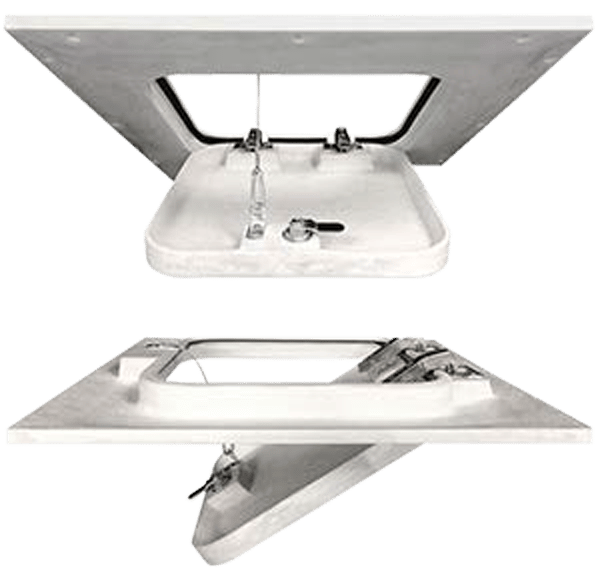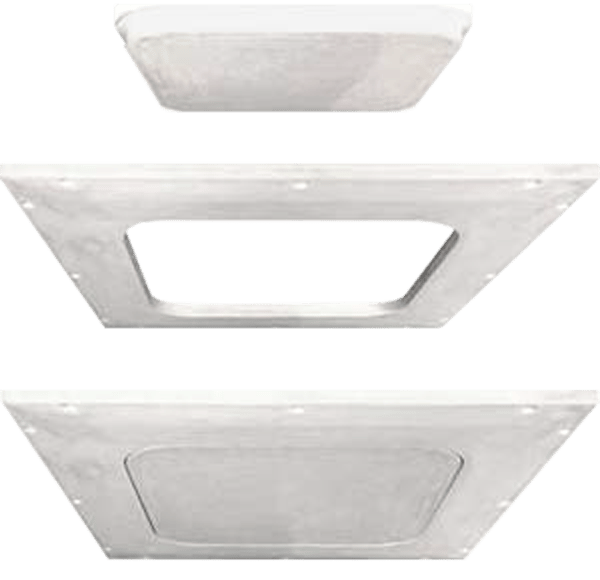The industry once had a problem with unsightly access panels almost everywhere you turned. Today, that problem is combated with GFRG.
By Ron R. Chelli
Not Seeing
is Believing,
Thanks to GFRG Access Panels
The industry once had a problem with unsightly access panels almost everywhere you turned. Today, that problem is combated with GFRG.
By Ron R. Chelli
Access panels in a building’s hard ceilings or walls are abundant. Necessary to enable accessibility to plumbing, electrical, mechanical, and HVAC, they are ubiquitous. Used in both new construction and retrofit, they are installed, to some degree, in virtually every commercial, residential, and institutional project built.
Whether it’s a hotel lobby, a hallway, a condominium, a health club, a restaurant, a mall, etc., one is sure to notice the sheer number of access panels used throughout construction projects worldwide.
They are available in various iterations, and the most used methods seem to all result in some degree of inferior design and/or function. You may see a customized access panel hidden in a home’s closet that features a square piece of drywall or plywood door accompanied by a picture frame. Then there are flimsy plastic doors, which fit within an equally flimsy plastic frame. And finally, the most often utilized commercial access doors are the omnipresent metal version, which look fine when new, but become an unmitigated eyesore over time.
The above examples have been used for many years, while being generally deemed a necessary evil. Certainly functional must-haves, but generally accepted as aesthetically challenged. Or in layman’s terms, simply ugly. And the biggest culprit are the prefinished metal access doors that have dominated the market for decades.
You’ve undoubtedly seen them. Unhidden, disheveled and poorly fit frames and doors. Visible surface screw heads. Scratched and worn surfaces. And the all-too-familiar rusted doors and frames in hotel bathrooms.
To See or Not to See
The problem, prior to the advent of Glass Fiber Reinforced Gypsum Access Panels, was that there really were no viable solutions to these unsightly doors. Metal access panels were the accepted means to provide necessary access. Architects and interior designers indifferently specified them as they were essentially forced to begrudgingly accept this inferior solution. Contractors bought and installed them because they were included in the specification. They were the default answer, but with a very marginal aesthetic. Certainly necessary, yet unattractive nonetheless, as access points in a building are a must-have and they had no better options.
The advent of GFRG Access Panels changed this paradigm, however. They’ve offered designers and building owners the opportunity to proudly highlight their respective spaces without the distraction of unsightly and unappealing access panels. These precision molded GFRG panels are lightweight, easily textured, do not shrink or crack, and blend discreetly into surrounding drywall, all while reducing costly labor.
They’ve also been specified and installed extensively throughout some of the most recognizable and prestigious brands’ buildings, such as Disney, Marriott, Hilton, Starbucks, Ritz-Carlton, Apple and Hyatt for more than two decades.
Additionally, GFRG has been designed, molded and installed for over 40 years and in 35 countries. Made of high strength alpha gypsum, it is reinforced with glass fibers that are most often factory-molded into virtually any shape or size needed. It is a non-combustible material (test results of flame spread and smoke development values as per ASTM E-84) and even the largest manufactured parts weigh only 2-3 pounds per square foot (10-15 kg/m2).
Similar to traditional plaster castings, but considerably lighter and stronger, Glass Fiber Reinforced Gypsum is typically field finished with any interior paint. Joints can be taped and finished as one would do with drywall finishing. They are used in a range of architectural applications such as ceilings, column covers, decorative wall panels, domes, bulkheads, light coves and of course, access panels.
The use of post-consumer recycled materials, and the fact that GFRG castings are made to size and are designed to minimize excessive framing, makes GFRG a favorable choice for LEED or “green” construction projects, as well.


Features and Benefits to GFRG Access Panels
There are many features and benefits of GFRG access panels’. To name a few:
- Tapered edge surround frames with pre-drilled/spotted fastener holes and drop-in (ceilings) or hinged doors (walls)
- (3) hinged styles: Lock-Latch, Touch-Latch, or Keyless/Cam-Latch
- Seamlessly blend into any drywall ceiling or wall where periodic access is required
- Available for use in both Commercial and Residential construction
- Residential models incorporate energy-saving gaskets to prevent temperature altering attic air infiltration into living spaces
- Ideal for both New Construction and Retrofit
- Available in a wide range of standard/stock sizes
- Virtually unlimited capacity to customize
- Available in square, round, and radius
For more peace of mind, the following rigorous industry standards have been developed to ensure long-lasting quality when choosing GFRG Access Panels:
- Zero-VOC alpha-gypsum mined in the USA
- Glass mat incorporated for strength
- ASTM testing including the all-important ASTM E84 (0/0 smoke/flame)
- 2.5 lbs./ft² high strength composition
- LEED supported
With all of these significant qualities, GFRG Access Panels provide discrete access behind drywall ceilings and walls for a wide range of applications. Rather than distracting from a building’s aesthetics, they enhance them. Available access points are vitally important to a building’s inhabitants and will certainly continue to be so. However, what was once accepted as a necessary eyesore, can now be an enhancement. No need to ever again sacrifice form over function. From now on, think: Clean. Simple. Hidden.
Images courtesy of Wind-lock Corp.
Ron Chelli is president of Wind-lock Corp. He has been involved in the EIFS industry since 1980. Chelli can be reached at ron.chelli@wind-lock.com.
Scroll Down
Scroll Down
